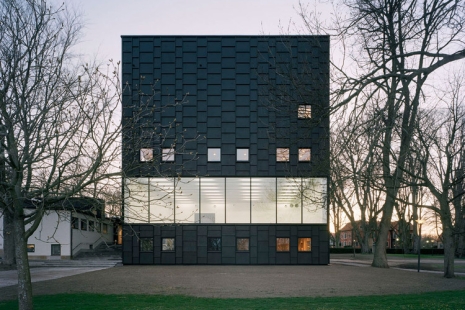The exhibition’s title comes from a concept coined in 2003 by the Australian ecophilosopher Glenn Albrecht. In his research, he examines, among other things, the relationship between environmental destruction and deteriorating mental health (grief) for those who live near areas that are changing. Glenn Albrecht’s research has come to be used in interdisciplinary discussions as well as in film, literature and art.
In the work Solastalgia, the Dutch artist Eline Kersten (b.1994) has used the concept as a starting point to investigate how people are affected by the closure of a limestone quarry in the Netherlands. The film shows how a transformation took place from industry to nature area and different voices are highlighted from the people involved. Eline Kersten shows how a place can hold many different memories and how the grief and the story can look different depending on whose perspective is taken into account.
What will the landscape of the future look like? Two artists who depict man’s relationship with nature are Ella Tillema (b. 1983) and Nils Kreuger (1858–1930). For Nils Kreuger, nature was very important, not just to depict but to actively roam around in. At the turn of the 19th and 20th centuries, cities were on the rise and many artists found a task in reflecting the open and free landscape.
Nils Kreuger’s national-romantic paintings of Öland’s landscapes stand in contrast to Ella Tillema’s contemporary works, Tomorrow will probably be good (red) (2016) and Peak (2020). Krueger and Tillema’s painting is grand, beautiful, sad, melancholic and powerful. However, one thing becomes clear – man’s inferiority to nature. We look easy in comparison. At the same time, man is also nature, we cannot be separated. Another aspect of the climate issue is the connection to consumption, economy and everyday life. Which way is best to go? How is a fair distribution created? Is it possible to break established patterns?
In the film My Burden (2017), the artist Niki Lindroth von Bahr (b. 1984) has created a modern fable with several layers. Fish, monkeys and mice play different characters who are placed in recognizable and emotionally charged situations. It takes place, for example, in a long-term hotel, a grocery store and a hamburger restaurant. The tone is wistful and comical at the same time. At times it is very lonely, like a cry for help out into an infinite universe. The characters seem locked in their existence in the modern society that both gives and takes. A work that is more difficult to interpret, but which in turn carries references far back in time, is the film The Drowned World (2020).
The American artist Michael Wang (b.1981) works in his artistry with film and installations around climate change, resource distribution and global economy. In The Drowned World, the viewer sees animals and plants related to the flora and fauna of the Carboniferous period, about 350 million years ago, and the image flow is interspersed with two narrations. One of the texts comes from J.G Ballard’s science fiction novel The Drowned World (1962), a literary work that predicted a future climate collapse. Michael Wang’s film opens with a dragonfly, one of the oldest insect orders of living insects dating back to the Carboniferous period. In a poetic way, the film reflects on what time is and gives a dizzying perspective on the history of the earth.
Catrin Andersson (f. 1974) bryter i sin tur ner detaljer från vetenskaplig forskning och visualiserar det synliga och, för det mänskliga ögat, osynliga världar i teckningsserien Glaciär (Sara Ugma) (2022). Hon intresserar sig för händelser som påverkat eller kommer att påverka naturen. När hon hörde om en skogsbrand som våren 2022 härjade nära glaciären Sara Ugma i Himalaya ville hon omsätta det i bild. Forskare uttryckte oro över hur sotet från elden riskerade medföra negativ snösmältning från glaciären. Parallellt läste hon om hur extremtemperaturer blir allt vanligare och att färgen röd inte längre räcker till för att markera den varmaste zonen – en färgblandning av magenta och blåviolett har fått läggas till för att illustrera temperaturer mellan 51–54 grader.
Solastalgia – klimat & framtid är ett samarbete med Linneuniversitetet (LNU) och pågår samtidigt som konferensen ENVIRONMENTAL EMERGENCIES ACROSS MEDIA 16–18 mars 2023. En av huvudfrågorna för konferensen är hur klimatkrisen och dess konsekvenser kan kommuniceras. Samarbetet mellan Kalmar konstmuseum och LNU ger en möjlighet att utbyta erfarenheter och låta vetenskap och konst mötas.





